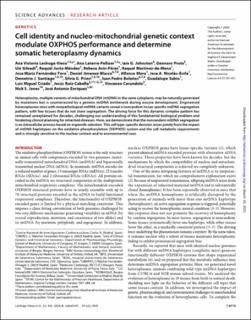Cell identity and nucleo-mitochondrial genetic context modulate OXPHOS performance and determine somatic heteroplasmy dynamics
Lechuga-Vieco, Ana Victoria; Latorre-Pellicer, Ana; Johnston, Iain; Prota, Gennaro; Gileadi, Uzi; Justo-Méndez, Raquel; Acín-Pérez, Rebeca; Martínez-De-Mena, Raquel; Fernández-Toro, Jose María; Jimenez-Blasco, Daniel; Mora, Alfonso; Nicolás-Ávila, Jose A.; Santiago, Demetrio J.; Priori, Silvia G.; Bolaños, Juan Pedro; Sabio, Guadalupe; Criado, Luis Miguel; Ruíz-Cabello, Jesús; Cerundolo, Vincenzo; Jones, Nick S.; Enríquez, Jose Antonio
Journal article, Peer reviewed
Published version

Åpne
Permanent lenke
https://hdl.handle.net/11250/2766754Utgivelsesdato
2020Metadata
Vis full innførselSamlinger
- Department of Mathematics [939]
- Registrations from Cristin [9791]
Sammendrag
Heteroplasmy, multiple variants of mitochondrial DNA (mtDNA) in the same cytoplasm, may be naturally generated by mutations but is counteracted by a genetic mtDNA bottleneck during oocyte development. Engineered heteroplasmic mice with nonpathological mtDNA variants reveal a nonrandom tissue-specific mtDNA segregation pattern, with few tissues that do not show segregation. The driving force for this dynamic complex pattern has remained unexplained for decades, challenging our understanding of this fundamental biological problem and hindering clinical planning for inherited diseases. Here, we demonstrate that the nonrandom mtDNA segregation is an intracellular process based on organelle selection. This cell type–specific decision arises jointly from the impact of mtDNA haplotypes on the oxidative phosphorylation (OXPHOS) system and the cell metabolic requirements and is strongly sensitive to the nuclear context and to environmental cues.
